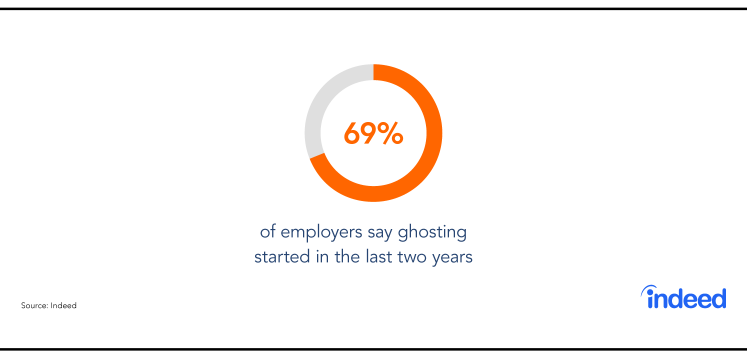Getting ghosted may not feel good, but it’s preferable to being stood up on a date. Unfortunately, both of these online dating experiences have crossed over into the hiring world and are becoming a growing human resource problem.
It appears that candidates who show up for scheduled interviews and their first day of work are turning into a rare breed.
Even large corporations aren’t immune to no-shows. Southwest Airlines reported that 15-20% of new hires don’t show up for the first day of work.
The tides have turned, and it’s a candidate’s market out there. People looking for jobs can be picky, and it’s up to businesses to find trustworthy job applicants and foster better attendance right from the start.
Keep reading to discover issues in your talent acquisition process that may be causing candidate no-shows and steps you can take today to turn recruitment into a retention asset.
An Increase in Candidate Ghosting and No-Shows
Ghosting and no-shows are two sides of the same noncommittal coin, and neither of them does any favors to your business. But they are technically two different things, and you should know the differences if you want to learn to solve them.
What Is Ghosting in Recruitment?
Candidate ghosting refers to a candidate not showing up for an interview even after confirming a scheduled time. A 2020 survey by Indeed found that 83% of employers had been ghosted during the hiring process, and more than half of respondents say the trend is increasing.
No-Show vs. Ghosting
In contrast, when a candidate accepts a job offer and signs a contract but doesn’t call or show up on their start date, that’s a no-show. 65% of employers have experienced a no-show from someone who had accepted a job offer.

While no-shows aren’t as common as interview ghosting, the impact is much more significant. It’s a reality that businesses have to deal with now, and it’s incredibly expensive.
When a candidate no-shows, it delays everything. At this point, you’ve closed the position and set up onboarding for your new employee. When they don’t show up or respond to your calls on the first day, you’re left having to reopen the job once more and go through the hiring process again.
Ideally, you want to eliminate both, but this article focuses on the more expensive problem first: no-shows.
Shifting the Recruitment Approach
Sadly, troubling dating app behavior has officially crossed over into the hiring process.
What does that mean for businesses?
It means that retention strategies don’t start on the first day of work; they begin during recruitment.
Recruiters are uniquely positioned to create a competitive edge for their businesses, but they have to make some serious changes.
Think about it.
If you had a friend that kept getting stood up by dating app hopefuls, at some point, you’re going to think, “where there’s smoke, there’s fire.”
In other words, something’s got to give, and it’s not going to be the candidates right now. Let’s face it. There are roughly two job openings for every person seeking, so it’s time for employers to compete.
Minimizing candidate no-shows requires a two-part approach. First, changing what you assess during recruitment and hiring, and second, leveling up how you deliver job offers.
Here are nine steps to shift the way you approach recruitment and start finding job candidates you can count on to be there for their first day.
1. Ask About Their Job Search
It’s not always comfortable to ask someone if they’re “seeing other people.” Still, it’s a must in the recruiting process. As for dating, that’s your business.
But, in all seriousness, recruiters should take the lead in setting up a more transparent job search.
Why?
Here are the top reasons Indeed found why candidates ghost:
- The hiring process was too long
- Not enough transparency
- The candidate just didn’t know what to do
- The job seeker didn’t want to hurt the recruiter’s feelings
Recruiters can address these issues by learning about a candidate’s job search early on and letting talent know how to notify the company if they’re going another direction.
In particular, you need to know if the candidate is talking to somebody else, how far they are in other interview processes, and what their timeline is for moving on and accepting a new position.
2. Personalize the Recruiting Process
Setting the stage for retention means getting to know your candidates and building relationships. Recruiters and companies need to get closer to the talent during the hiring process, so job seekers don’t feel comfortable not showing up without warning.
Personalizing is more than just staying in touch and communicating about scheduling. As a recruiter, you need to find your candidate’s “why.”
Why are they looking for a new job? Why would they choose one company over another?
Don’t assume that all people care about the same things. Each job offer needs to be unique, so get to know your candidates.
3. Make Timing Your Advantage
Many recruiters make the mistake of giving candidates too much space and time since they don’t want to seem pushy.
Instead, consider keeping up the excitement about the job by ensuring you’re in communication when a candidate’s interest is highest.
In particular, you should get back in touch right after a candidate’s interview with hiring managers or other team members to see what they’re thinking.
It’s also important to build reciprocity by communicating your company’s timeline and when people will hear about your decision. This helps build trust and reciprocity.
4. Assess Their Yes
Not all yeses are created equal. Some people are more inclined to flake or go back on their decisions. It’s your job to figure out who’s who.
Unfortunately, this isn’t the type of question you can necessarily ask talent. But you can ask their references questions like “Do you trust this person to show up and get the work done when needed?” and “Would you rehire this person?”
As Reagan put it, “Trust but verify.” Don’t beat around the bush on reference calls. Take the opportunity to get the information you need.
5. Level Up Your Job Offer
Have you ever heard of someone proposing via email? No, because it’s perhaps the most impersonal way to ask someone to commit to something. Yet, it’s not unheard of for recruiters to send job offers via email using some pre-written email templates.
Job offers need to be better, especially if you’re interested in landing top talent.
If you can’t meet in person, get on a video conference or a phone call. Bring their future manager or team members and make it an exciting announcement.
At the end of the day, the job offer isn’t just a transaction. It’s your opportunity to show a candidate that they’re wanted by your company and build excitement for the first day.
6. Keep the Excitement Up
In reality, your job as a recruiter does not end once a candidate accepts. Keep up the excitement by showing appreciation.
[IMAGE SUGGESTION]
You can send thoughtful gifts like congratulatory flowers or online gift cards. It may sound old school, but it works. Show love and continue to reinforce the idea of reciprocity. In other words, in this job market, you can’t take acceptance for granted anymore.
7. Communicate Until the First Day
So, let’s say a recruiter has the perfect job offer call. Everyone’s excited, the candidate signs the offer, and then on the first day, two weeks later….no call, no new person.
What went wrong? Odds are there was little to no follow-up between the offer call and their first day. If they don’t hear from you after they sign, it’s much easier for them to justify a no-call, no-show if something better comes along.
If you have a couple of weeks between someone accepting and starting, spread out your welcome information over a few emails so you can keep in touch. Figure out a cadence that works with your company culture, but do not give a candidate days of silence before their first day.
Oh, and this should go without saying, but don’t assign work before the first day. Remember, you’re building excitement, not squashing it.
8. Watch for Signs of Decreased Interest
When someone ghosts in the dating world, chances are there were signs before it happened. And, maybe not surprisingly, the signs are very similar when dealing with a candidate who might get cold feet.
All of a sudden, those prompt and detailed responses turn into infrequent and noncommittal answers. If you’re dealing with this, you should address it with the candidate. You can ask directly, “Are you still interested in the job?” or “Have you accepted another offer?”
You may not be able to prevent every candidate from taking another role, but you can avoid a no-show by identifying someone who’s lost interest before you send a job offer.
9. Keep a Record of No Shows
While all of the previous tips can help you build better relationships with candidates and minimize no-shows, there’s no way to guarantee that it won’t happen to you. What you can do is make sure that you don’t make the mistake of re-interviewing someone who didn’t show up for work the last time around.
[IMAGE SUGGESTION]
According to Indeed, 93% of organizations keep records of employees that don’t show up on the first day of work. If you’re one of the 7% that doesn’t, you should start now.
You can even extend the tracking to people that ghost on interviews if you want to protect your time and focus on more reliable candidates.
Final Thoughts: How To Prevent Candidate Ghosting During and After Hiring
Nobody wants to be stood up, whether it’s a first date or day of work. For better or for worse, the hiring process has a lot in common with modern dating. And now that job seekers can be picky, it’s up to recruiters to hone their process and build stronger relationships from the start.
And it’s not just about working harder. It’s about screening smarter and learning how to keep the excitement up, so your new hires feel like valued team members before day one.
The good news is that you don’t have to do it alone. JobScore provides recruiters with the technology to build a competitive recruitment strategy, whether you have 5 open roles or 50. Explore JobScore today and start building a better candidate experience.



